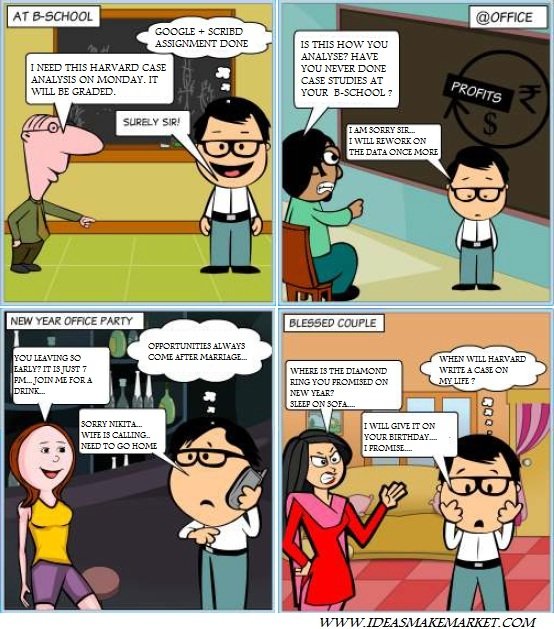Imagine the fate of Apple Inc. without Steve Wozniak, popularly referred to as the brains behind arguably the world’s most innovative corporation. On the other hand, the all-popular Steve Jobs, the face of Apple Inc, was a sheer marketing genius. Steve Wozniak is a well-known introvert as contrasted by his former partner Steve Jobs, a seasoned extrovert. Do you think Apple Inc. would have been even a fraction as huge as it is today, had it not been for their synergetic relationship?

A history-backed common observation suggests that innovation is not a group-task, as deferred to the flawed conception of many organizations and even b-schools which overtly emphasize on group activities for even analytical subjects like Statistics; the benefits only known to them. All innovations have come from people who have the ability to think in the direction in which people usually do not. ‘E=mc2 did not come out of a group activity nor did the ‘law of gravitation’. The business world nowadays fails to recognize this very basic fact about innovation. Diversity in general, especially that in terms of extraversion-intraversion plays a crucial role in today’s organization, with or without their knowledge of this being important.
The trends suggest that businesses, these days, are hunting for good communicators and good presenters, loosely known as extroverts, and despise introverts. This, in turn, is making these businesses schematically less diverse. Somewhere this mentality is also reflected in the fact that Indian firms have exceptionally low research and development expenditure compared to various countries across the globe; a worrisome 0.9% of GDP when USA, China, Japan, Germany, South Korea and the likes are spending more than 2% of their respective GDPs. The intrinsic drive to innovate is absent. Try to remember one invention done by an Indian in India. Try to remember one Indian brand that generates half the craze abroad as what Apple or Google generate in India. This should ideally not be as tough to think as it is.
A recent study by consulting and professional services company Deloitte suggests, cultivating ‘diversity of thought’ can boost innovation and creative problem-solving in organizations. Today, the firms, slowly but surely are realizing this as we see organizations partially outsourcing non-value-adding, rote tasks, and becoming more diversity-friendly at least in words, if not in spirit as exemplified by their self-portrayal as multi-ethnic, multi-national organizations.
Many Indian firms, though, summarily forget about the diversity aspect of their firms and keep on going with the flow, following the universally accepted norms of how businesses usually run, not trying to walk on ‘the road less travelled’. Most b-schools are left with no options but to follow the industry in all its vagaries, in turn, increasingly dishing out stereotyped employees for increasingly ‘stereotypifying’ industries. This completes the vicious cycle of what I call ‘anti transformation’.
In the near future, ‘innovativeness inventory’ of firms, will become the most determining factor contributing to their success in, what is going to be, an extremely competitive market. That, coupled with narrowing business life-cycles, creates an added responsibility on the future Human Resources departments or ‘People function departments’, as they are predicted to be called in the time to come, to impart this innovative edge to their organization by bringing in diverse ideas through a diverse pool of ‘ideators’. A change in the workforce composition demands a change in the methods to manage them and to reward them, through motivators, to get the maximum out of the minimum.
According to Dan Pink, an author and a pro-innovation speaker, innovativeness thrives in the presence of intrinsic motivation and extrinsic motivators, such as additional perks, decrease the productivity when the task requires a certain degree of innovativeness. This ineffectiveness in PMS of many organizations can be countered by incorporating changes in the policies and keeping them flexible enough to accommodate more diversity in the organization. The three most innovative companies in the world, for instance, viz. Apple, Google and 3M are known far and wide for their idea generation tactics. The ’15 percent rule’, ideated and implemented by 3M, proposes that its employees spend 15 percent of their work time to randomly ideate. They stimulate unplanned experimentation of these random ideas or ‘whims’ with the hope that they may turn into unexpected, but successful innovations and new opportunities for the company. This, though sounds good and even yields favorable results, is rarely followed by other organizations. There is a tacit resistance to change in big companies. There is a serious disconnect between science and business which is all the more evident in the Indian scenario.
As an ending note, I again would like to mention one fact about Apple Inc.’s two famous Steves, ’They were a deadly combination of introvert and extrovert; introvert to innovate, extrovert to implement’. This should get the HR minds ticking as to how an optimum ratio of introverts viz-a-viz extroverts, can be determined and maintained in today’s change-demanding business scenario. As a budding H.R. manager, this is a simplistic proposal from my side to keep a check on diversity that, if added to the armory of today’s organizations, I believe can make them more adversity-immune.
[The article has been written by Tarun Shakyawar. He is presently pursuing his MBA from SIBM, Pune]


































